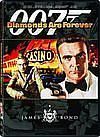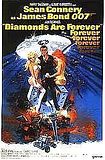James Bond
Diamonds Are Forever (1971)
Diamonds Are Forever (1971) is the seventh spy film in the James Bond series, and the sixth to star Sean Connery as the fictional MI6 agent James Bond. The film is based on Ian Fleming's 1956 novel of the same name, and is the second of four James Bond films directed by Guy Hamilton. The story has Bond impersonating a diamond smuggler to infiltrate a smuggling ring, and soon uncovering a plot by his old nemesis Blofeld to use the diamonds and build a giant laser satellite that would be used to hold the world for ransom.
Diamonds Are Forever was a commercial success, but its humorous tone was met with mixed reviews by critics.
Plot
In the pre-title sequence, James Bond is pursuing Ernst Stavro Blofeld, who was responsible for the death of his wife. After interrogating several of Blofeld's associates worldwide, Bond traces him to a facility where he is surgically creating look-alikes. Bond kills a test subject who is lying in a mud bath. Bond manages to drown the man, but is captured by Blofeld. After a fight, Bond kills Blofeld by throwing him into a pool of superheated mud.
Suspecting that South African diamonds are being stockpiled to depress prices by dumping, and convinced that Blofeld is dead, M orders Bond to replace a diamond smuggler named Peter Franks and unveil his associates. Meanwhile, Blofeld's henchmen Mr. Wint and Mr. Kidd systematically murder several diamond smugglers to cover up their trail. Posing as Franks, Bond travels to Amsterdam to meet a smuggler, Tiffany Case, at her apartment. However, Franks escapes from custody and reaches Case's apartment. Bond intercepts and kills him with a fire extinguisher after a fight in a lift, then switches wallets to make Case think James Bond is dead. The two then smuggle fake diamonds to Los Angeles within Franks' corpse.
At the airport Bond meets his CIA ally Felix Leiter and transports the body to Slumber Inc., a funeral home where another smuggler, Shady Tree, quickly realises that the diamonds are fake. Bond tells Leiter to ship the real diamonds while he heads for Las Vegas where Tree works as a stand-up comedian; however, Tree is killed by Wint and Kidd. Later in the casino, Bond meets a girl named Plenty O' Toole and takes her to his room, but she is shortly evicted (out the window and into the hotel swimming pool) by the smugglers, who have come for the real diamonds. Instead, Bond spends the night with Case, who has been waiting in the suite's bedroom in order to get him to talk about the true location of the diamonds. Bond sends her to retrieve the diamonds at a circus, but she loses her watchers despite the proclaimed fool-proof surveillance by Leiter and the CIA.
Bond reveals his identity to Case when the latter returns to her operation residence and finds the body of Plenty, who was killed when mistaken for Case. Having survived the attempt on her life, the initially reticent Case decides to assist him in his mission. Posing as a lab worker, Bond enters the apparent destination of the diamonds a laboratory owned by reclusive Las Vegas millionaire Willard Whyte, where he finds laser refraction specialist Professor Dr. Metz constructing a satellite. He flees by stealing a moon buggy and reunites with Case in a car chase with security and the local police. They return into town where Bond scales the walls to the top floor of the Whyte House. Inside, he is disarmed and confronted by two identical Blofelds who are posing as Whyte using an adapted telephone to mask their voice Bond had previously killed a look-alike. Not knowing which to kill, Bond kicks Blofeld's cat into the arms of its owner and shoots him. However, the cat also turns out to be a look-alike.
Bond is rendered unconscious and then left inside a pipeline by Wint and Kidd. He escapes and contacts Blofeld, posing as one of Whyte's employees and Blofeld's middle-men, Bert Saxby. Learning about Whyte's penthouse, Bond goes there and fights the bodyguards Bambi and Thumper, forcing them to tell him where Whyte is. The latter is rescued, but Blofeld abducts Case. With the help of Whyte, Bond raids the lab and uncovers Blofeld's plot to create a laser satellite using the diamonds, which is now in orbit. Blofeld destroys nuclear installations in the United States, Russia, and China, then proposes an international auction for global nuclear supremacy.
Bond identifies an oil rig off the coast of Baja California as Blofeld's base of operations. Arriving at the rig, he switches the cassette containing the codes which control the satellite with a music tape, giving the coded one to Case who is living there as a hostage. However, trying to be helpful, she switches the tapes back. As Blofeld plans to attack Washington D.C. using the satellite, Whyte and Leiter lead an air assault on the base. Blofeld tries to escape on a mini-sub, but Bond gains control of it, and crashes the sub into the control room, defeating Blofeld and destroying the satellite control along with the rest of the base.
Bond and Case then head for home on a cruise ship, where Wint and Kidd also board disguised as waiters. Bond sees through their disguise, and kills them when they try to assasinate him. The film ends with Tiffany wondering about how to get all the diamonds from the laser satellite back down to Earth.
Cast
- Sean Connery as James Bond: An MI6 agent who acts as a diamond smuggler to infiltrate a smuggling ring. He uncovers a plot by Blofeld to use the diamonds to build a giant laser satellite.
- Charles Gray as Ernst Stavro Blofeld: A megalomaniac, and the head of SPECTRE. He uses diamonds to construct a satellite weapon. Gray was previously in the Bond film series when he played Dikko Henderson in 1967's You Only Live Twice.
- Jill St. John as Tiffany Case: A diamond smuggler who unknowingly hires Bond to assist her. She survives an assassination attempt and then unites with Bond to battle Blofeld.
- Jimmy Dean as Willard Whyte: An entrepreneur who is kidnapped and his identity misused by Blofeld. He later assists Bond in defeating SPECTRE.
- Bruce Glover as Mr. Wint and Putter Smith as Mr. Kidd: Blofeld's henchmen who methodically kill all the diamond smugglers except Case.
- Bernard Lee as M: The strict head of MI6.
- Lois Maxwell as Miss Moneypenny: M's secretary.
- Desmond Llewelyn as Q: Head of MI6's technical department.
- Norman Burton as Felix Leiter: CIA agent and Bond's ally in tracking Blofeld.
- Joe Robinson as Peter Franks: Diamond smuggler whose identity is taken by Bond.
- Lana Wood as Plenty O'Toole: Bond's opportunistic would-be girlfriend, who is mistakenly drowned by Kidd and Wint. * Bruce Cabot as 'Bert' Saxby: Whyte's casino manager in cahoots with Blofeld.
- Leonard Barr as Shady Tree: A Casino stand-up comedian and another smuggler.
- Laurence Naismith as Sir Donald Munger : Diamond expert who brings the case to MI6.
- Lola Larson and Trina Parks (uncredited) as Bambi and Thumper: Two bodyguards of Blofeld's holding Whyte captive.
Directed by Guy Hamilton Produced by Harry Saltzman Albert R. Broccoli Novel/Story by Ian Fleming Screenplay Richard Maibaum, Tom Mankiewicz Cinematography by Ted Moore Music by John Barry Main theme Diamonds Are Forever Composer John Barry Don Black Performer Shirley Bassey Editing by Bert Bates John Holmes Distributed by United Artists Released 17 December 1971 (USA) 30 December 1971 (UK) Running time 115 min.
Production
The producers originally intended to make Diamonds Are Forever an extensive reboot of the film series to appeal to an American audience. The objective was revivification of the aspects of Goldfinger, including hiring its director, Guy Hamilton.[1]
Script
This was the last Bond movie by Eon to use SPECTRE or Blofeld elements that had not been featured in Ian Fleming's book, the content of which was almost entirely eschewed in the adaptation. After this, writer Kevin McClory's legal claim against the Fleming estate that he, and not Ian Fleming, had created the organization for the novel Thunderball was upheld by the courts. Blofeld is seen but not identified later in For Your Eyes Only (1981), as Eon's arrangements with the Fleming estate did not permit them to use McClory's works.
The original plot had as a villain Auric Goldfinger's twin, seeking revenge for the death of his brother. The plot was later changed after Albert R. Broccoli had a dream, where his close friend Howard Hughes was replaced by an imposter. So the character of Willard Whyte was created, and Tom Mankiewicz was chosen to rework the script.[2] The adaptation eliminated the main villains from the source Ian Fleming novel, mobsters called Jack and Seraffimo Spang, but used the henchmen Shady Tree, Mr. Wint and Mr. Kidd.[2]
Richard Maibaum's original idea for the ending was a giant boat chase across Lake Mead with Blofeld being pursued by Bond and all the Las Vegas casino owners who would be sailing in their private yachts. Bond would rouse the allies into action with a spoof of Lord Nelson's famous cry, "Las Vegas expects every man to do his duty." Maibaum was misinformed; there were no Roman galleys or Chinese junks in Las Vegas, and the idea was too expensive to replicate, so it was dropped.[3]
Maibaum may have thought the eventual oil rig finale a poor substitute, but it was originally intended to be much more spectacular. Armed frogmen would jump from the helicopters into the sea and attach limpet mines to the rig's legs (this explains why frogmen appear on the movie's poster). Blofeld would have escaped in his BathoSub and Bond would have pursued him hanging from a weather balloon.[4] The chase would have then continued across a salt mine with the two mortal enemies scrambling over the pure white hills of salt before Blofeld would fall to his death in a salt granulator. Permission was not granted by the owners of the salt mine. It also made the sequence too long. Further problems followed when the explosives set up for the finale were set off too early; fortunately, a handful of cameras were ready and able to capture the footage.[3]
Casting
George Lazenby vacated the role of James Bond on the questionable advice of his agent. Producers contemplated replacing him with John Gavin. However, United Artists' chief David Picker was unhappy with this decision and made it clear that Sean Connery should be enticed back to the role and that money was, essentially, no object. When approached about resuming the role of Bond, Connery demanded the then astronomical fee of 1.2 million[citation needed] (then $2 million, and over $20m inflation-adjusted for 2005) and to entice the actor to play Bond one more time United Artists would back two films of his choice. When both sides had agreed to the deal Connery used the fee to establish the Scottish International Education Trust where Scottish artists could apply for funding without having to leave their country to pursue their careers. As John Gavin was no longer needed his contract was paid in full by United Artists. The first film made under Connery's deal was The Offence directed by his friend Sidney Lumet.[1] The second was to be an adaptation of Macbeth by William Shakespeare using only Scottish actors and in which Connery himself would play the title role. This project was abandoned due to the Roman Polanski film version that was also in production at the same time. Sean Connery never played Macbeth on film, although his son Jason Connery later did.
Michael Gambon had been mentioned by Albert R. Broccoli as a possible candidate for Bond before Sean Connery returned. Although United Artists were reluctant to cast another relatively unknown actor, Gambon himself told Broccoli that he was "in terrible shape" and "had tits like a woman".[5]
Charles Gray was cast as master villain Ernst Stavro Blofeld, after playing a Bond ally called Henderson in You Only Live Twice (1967).[1] David Bauer who plays Morton Slumber previously appeared uncredited as an American Diplomat also in You Only Live Twice.
Jazz musician Putter Smith was invited by Harry Saltzman to play Mr. Kidd after a Thelonius Monk Band show. Musician Paul Williams was originally cast as Mr. Wint. But when he couldn't agree with the producers on money concerns, Bruce Glover replaced him. Glover said he was surprised for being chosen, because at first producers said he was too normal, that they wanted a deformed, Peter Lorre-like actor.[1]
Jimmy Dean was cast as Willard Whyte after Saltzman saw a presentation of him. Dean was much worried of playing a Howard Hughes pastiche, because he was an employee of Hughes at the Desert Inn.[1]
Actresses considered for the role of Tiffany Case included: Raquel Welch, Jane Fonda and Faye Dunaway. Jill St. John had originally been offered the part of Plenty O'Toole but landed the female lead after impressing director Guy Hamilton during screen tests. St. John became the first American Bond girl.[6] Lana Wood was cast as Plenty O'Toole following a suggestion of screenwriter Tom Mankiewicz.[1] The woman in the bikini named "Marie", who in the beginning of the film is convinced by Bond to give up the location of Blofeld, was Denise Perrier, Miss World 1953.[2]
Filming
Filming for Diamonds are Forever begun on 5 April 1971, with the South African scenes actually shot in the desert near Las Vegas, and finished in 13 August 1971.[1] The film was shot primarily at the Los Angeles International Airport,[7] Universal City Studios and eight hotels of Las Vegas.[8] Besides the Pinewood Studios in London, other places in England were Dover and Southampton. The climactic oil rig sequence was shot at the Oceanside of California. Other filming locations included Cap D'Antibes in France (the opening scenes), Amsterdam and Lufthansa's hangar in Germany.[9]
Filming in Las Vegas took place mostly in hotels owned by Howard Hughes, since he was a friend of Cubby Broccoli.[6] Getting the streets empty in order to shoot was achieved through the collaboration of Hughes, the Las Vegas police and shopkeepers association.[3] The Las Vegas Hilton dubbed for the Whyte House, and since the owner of the Circus Circus was a Bond fan, he allowed the Circus to be used on film and even made a cameo.[2][3] The cinematographers said filming in Las Vegas at night had an advantage: no additional illumination was required due to the high number of neon lights.[10]
The car chase where the red Ford Mustang comes outside of the narrow street on the opposite side in which it was rolled, was filmed over three nights on Fremont Street in Las Vegas. The alleyway car roll sequence is actually filmed in two locations. The entrance was at the car park at Universal Studios and the exit was at Fremont Street, Las Vegas.[1]
The site used for the Willard Whyte Space Labs (where Bond gets away in the Moon Buggy) was actually, at that time, a Johns-Manville gypsum plant located just outside of Las Vegas. The home of Kirk Douglas was used for the scene in Tiffany's house, while the Elrod House in Palm Springs became Willard Whyte's house.[9]
While filming the scene of finding Plenty OToole drowned in Tiffanys swimming pool, Lana Wood actually had her feet loosely tied to a cement block on the bottom. Film crew members held a rope across the pool for her, with which she could lift her face out of the water to breathe between takes. The pool's sloping bottom made the block slip into deeper water with each take. Eventually, Wood was submerged but was noticed by on-lookers and rescued before drowning for real. Wood, being a certified diver, took some water but remained calm during the ordeal, although she later admitted to a few "very uncomfortable moments and quite some struggling until they pulled me out."[11]
Since the car chase in Las Vegas would have many car crashes, the filmmakers had an arrangement with Ford to use their vehicles. Ford's only demand was that Sean Connery had to drive the 1971 Mustang Mach 1 which serves as Tiffany Case's car.[3] Other Ford vehicles include Blofeld's chief scientist's Ford Econoline van, Mr. Wint and Mr. Kidd's Thunderbird, and during the moon buggy chase, the security guards are driving Ford Custom 500s.
The Moon Buggy was inspired by the actual NASA vehicle, but with additions such as flaying arms since the producers didn't find the design "outrageous" enough. The fiberglass tires which NASA used had to be replaced during the chase sequence, because the heat and the irregular desert soil ruined them.[12]
Music
"Diamonds Are Forever", the title song, was the second James Bond theme to be performed by Shirley Bassey, after "Goldfinger" in 1964. Producer Harry Saltzman reportedly hated the song, and only the insistence of co-producer Cubby Broccoli kept it in the film. Saltzman's major objection was to the sexual innuendo of the lyrics. Indeed, in an interview for the television programme James Bond's Greatest Hits composer John Barry revealed that he told Bassey to imagine she was singing about a penis. Bassey would later return for a third performance for 1979's "Moonraker."
The original soundtrack was once again composed by John Barry. This was his sixth time composing for a James Bond film. The song has subsequently been sampled by rapper Kanye West in the track Diamonds from Sierra Leone. It was also used by hip-hop group Dead Prez on the song "Psychology" from Let's Get Free.
References
- ^ a b c d e f g h Inside Diamonds Are Forever: Diamonds Are Forever Ultimate Edition, Disc 2 (NTSC, Widescreen, Closed-captioned) [DVD]. MGM/UA Home Video. Retrieved on 2007-12-24. ASIN: B000LY2L1Q.
- ^ a b c d John Cork. Commentary track: Diamonds Are Forever Ultimate Edition, Region 4 [DVD]. Retrieved on 2008-02-11.
- ^ a b c d e Guy Hamilton. Commentary track: Diamonds Are Forever Ultimate Edition, Region 4 [DVD]. Retrieved on 2008-02-11.
- ^ Oil Rig Attack: Diamonds Are Forever Ultimate Edition, Disc 2 [DVD]. Retrieved on 2008-02-02.
- ^ David Walliams takes some acting tips from Michael Gambon, The Sunday Times
- ^ a b Album notes for Diamonds Are Forever Ultimate Edition DVD. MGM/UA Home Video (ASIN: B000LY2L1Q).
- ^ "Los Angeles". Postcard Destinations. Voyager Channel, Mumbai. 2008-01-07. 8 minutes in.
- ^ Diamonds Are Forever: Region 2 (PAL) [DVD]. Retrieved on 2008-02-02. ASIN: B00004VUHC.
- ^ a b Exotic Locations: Diamonds Are Forever Ultimate Edition, Disc 2 (NTSC, Widescreen, Closed-captioned). Retrieved on 2008-02-02. ASIN: B000LY2L1Q.
- ^ Peter Lamont. Commentary track: Diamonds Are Forever Ultimate Edition, Region 4 [DVD]. Retrieved on 2008-02-11.
- ^ Lana Wood. Commentary track: Diamonds Are Forever Ultimate Edition, Region 4 [DVD]. Retrieved on 2008-02-11.
- ^ Ken Adam. Commentary track: Diamonds Are Forever Ultimate Edition, Region 4 [DVD]. Retrieved on 2008-02-11.
- ^ "Diamonds Are Forever". Box Office Mojo. Retrieved on 2007-12-09.
- ^ "Diamonds Are Forever". TheNumbers. Retrieved on 2007-12-24.
- ^ "Diamonds are Forever (1971)". Rotten Tomatoes. Retrieved on 2007-12-24.
- ^ Roger Ebert (1971-12-01). "Diamond Are Forever review". Chicago Sun-Times. Retrieved on 2007-12-24.
- ^ Berardinelli, James (1996). "Diamonds Are Forever: A film review". Reelviews.net. Retrieved on 2008-02-05.
- ^ Null, Christopher. "Diamonds are Forever". Filmcritic.com. Retrieved on 2008-02-05.
- ^ Rhodes, Steve (1998). "Diamonds are Forever". IMDb Reviews. Retrieved on 2008-02-05.
- ^ "James Bond's Top 20". IGN (2006-11-17). Retrieved on 2007-12-21.
- ^ Norman Wilner. "Rating the Spy Game". MSN. Retrieved on 2007-12-21. 22. ^ Chris Hicks (2008-10-13). "Bond Month: The crappest Bond villians of all time", Total Film. Retrieved on 15 October 2008. 23. ^ "Academy Awards, 1972". Internet Movie Database. Retrieved on 2007-12-24.




